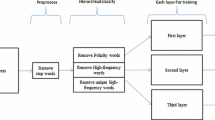Abstract
We explore the task of automatic classification of texts by the emotions expressed. We consider how the presence of neutral instances affects the performance of distinguishing between emotions. Another facet of the evaluation concerns the relation between polarity and emotions. We apply a novel approach which arranges neutrality, polarity and emotions hierarchically. This method significantly outperforms the corresponding “flat” approach which does not take into account the hierarchical information. We also compare corpus-based and lexical-based feature sets and we choose the most appropriate set of features to be used in our hierarchical classification experiments.
Access this chapter
Tax calculation will be finalised at checkout
Purchases are for personal use only
Preview
Unable to display preview. Download preview PDF.
Similar content being viewed by others
References
Wiebe, J., Wilson, T., Cardie, C.: Annotating Expressions of Opinions and Emotions in Language. Language Resources and Evaluation 39, 165–210 (2005)
Ekman, P.: An Argument for Basic Emotions. Cognition and Emotion 6, 169–200 (1992)
Aman, S.: Identifying Expressions of Emotion in Text. Master’s thesis, University of Ottawa, Ottawa, Canada (2007)
Neviarouskaya, A., Prendinger, H., Ishizuka, M.: Compositionality Principle in Recognition of Fine-Grained Emotions from Text. In: Proc. Third International ICWSM Conference, pp. 278–281 (2009)
Alm, C.O., Roth, D., Sproat, R.: Emotions from text: machine learning for text- based emotion prediction. In: Proc. Joint Conference on Human Language Technology / Empirical Methods in Natural Language Processing (HLT/EMNLP 2005), Vancouver, Canada, pp. 579–586 (2005)
Strapparava, C., Mihalcea, R.: SemEval-2007 Task 14: Affective Text (2007)
Strapparava, C., Mihalcea, R.: Learning to Identify Emotions in Text. In: Proc. ACM Symposium on Applied computing, Fortaleza, Brazil, pp. 1556–1560 (2008)
Chaumartin, F.: Upar7: A knowledge-based system for headline sentiment tagging. In: Proc. SemEval 2007, Prague, Czech Republic (June 2007)
Kozareva, Z., Navarro, B., Vazquez, S., Montoyo, A.: Ua-zbsa: A headline emotion classification through web information. In: Proc. SemEval 2007, Prague, Czech Republic (June 2007)
Katz, P., Singleton, M., Wicentowski, R.: Swat-mp: the semeval-2007 systems for task 5 and task 14. In: Proc. SemEval 2007, Prague, Czech Republic (June 2007)
Aman, S., Szpakowicz, S.: Using Roget’s Thesaurus for Fine-grained Emotion Recognition. In: Proc. Third International Joint Conf. on Natural Language Processing (IJCNLP), Hyderabad, India, pp. 296–302 (2008)
Kennedy, A., Inkpen, D.: Sentiment classification of movie reviews using contextual valence shifter. Computational Intelligence 22, 110–125 (2006)
Keshtkar, F., Inkpen, D.: Using Sentiment Orientation Features for Mood Classification in Blog Corpus. In: IEEE International Conf. on Natural Language Processing and Knowledge Engineering, Dalian, China, September 24-27 (2009)
Koller, D., Sahami, M.: Hierarchically Classifying Documents Using Very Few Words. In: Proc. International Conference on Machine Learning, pp. 170–178 (1997)
Kiritchenko, S., Matwin, S., Nock, R., Fazel Famili, A.: Learning and Evaluation in the Presence of Class Hierarchies: Application to Text Categorization. LNCS, pp. 395–406. Springer, Heidelberg (2006)
Wilson, T., Wiebe, J., Hoffmann, P.: Recognizing contextual polarity: an exploration of features for phrase-level sentiment analysis. Computational Linguistics 35(3), 399–433 (2009)
Strapparava, C., Valitutti, A.: WordNet-Affect: an affective extension of WordNet. In: Proc. 4th International Conference on Language Resources and Evaluation (LREC 2004), Lisbon, Portugal, pp. 1083–1086 (2004)
Jarmasz, M., Szpakowicz, S.: Roget’s Thesaurus and Semantic Similarity. In: Nicolov, N., Bontcheva, K., Angelova, G., Mitkov, R. (eds.) Recent Advances in Natural Language Processing III: Selected Papers from RANLP, John Benjamins, Current Issues in Linguistic Theory, vol. 260, pp. 111–120 (2003)
Riloff, E., Wiebe, J.: Learning extraction patterns for subjective expressions. In: Proc. Conference on Empirical Methods in Natural Language Processing (EMNLP 2003), Sapporo, pp. 105–112 (2003)
Witten, I.H., Frank, E.: Data Mining: Practical Machine Learning Tools and Techniques, 2nd edn. Morgan Kaufmann, San Francisco (2005)
Author information
Authors and Affiliations
Editor information
Editors and Affiliations
Rights and permissions
Copyright information
© 2010 Springer-Verlag Berlin Heidelberg
About this paper
Cite this paper
Ghazi, D., Inkpen, D., Szpakowicz, S. (2010). Hierarchical Approach to Emotion Recognition and Classification in Texts. In: Farzindar, A., Kešelj, V. (eds) Advances in Artificial Intelligence. Canadian AI 2010. Lecture Notes in Computer Science(), vol 6085. Springer, Berlin, Heidelberg. https://doi.org/10.1007/978-3-642-13059-5_7
Download citation
DOI: https://doi.org/10.1007/978-3-642-13059-5_7
Publisher Name: Springer, Berlin, Heidelberg
Print ISBN: 978-3-642-13058-8
Online ISBN: 978-3-642-13059-5
eBook Packages: Computer ScienceComputer Science (R0)




